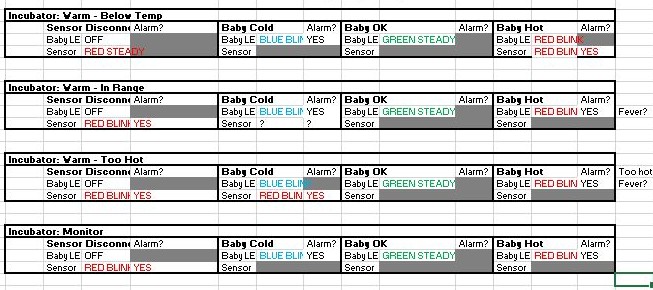I can’t emphasize enough how much real world experience helps to put years of learning and coursework from classes into perspective. Last week, I found and ordered switches that I would need to construct the mode selection part of the Incubaby UI. This week, I researched several different circuits to integrate a rotary switch and implemented the most promising one. By trial and error, I was finally able to see the voltage changes between each position on the switch, which supported the calculations I had done beforehand. Then, I devised a sketch in Arduino that takes these voltage measurements and associates them with the mode that the incubator needs to be in; the Arduino then switches over to the part in the code that runs the specified mode of the incubator. And there’s some of ELEC coming together to make some sense!
Coming into this week, I expected the Incubaby UI to be a reformatted version of the current front panel. However, it turned out to be a complete redesign of the front panel. It should account for different situations that would arise when the incubator is in use, including the notorious one in which the doctor/nurse doesn’t put the temperature sensor on the baby (Note: the incubator adjusts its temperature based on the baby’s temperature). It was overwhelming but interesting to see how devices are not always used in the way in which they were meant to be used. Additionally, we need to make sure that doctors/nurses can easily tell how well the baby is maintaining its temperature in the incubator. For this, we might use multicolor LEDs (another first for me) to inform the nurse/doctor if the baby is too cold (blue), too warm (red), or normal (green). The device should also remind the user to put the strap on the baby and alert if the strap is incorrectly placed on the baby. And we need to do all of this, while making sure that the doctors/nurses are not confused/intimidated by too many lights/alarms going off. The brainstorming for this UI was definitely very involved. Just when we thought we had covered all of the necessary components, we come up with handy things like “door open” alarms and sensor straps hanging from telephone wires.
I learned how to effectively use a matrix to decide when indicator lights should be on/off, what colors they need to be, what alarms need to go off, and what alarms take priority over others.
As you can probably tell, I need to work on making it a bit more coherent.
Alongside that, I’m having a lot of fun sketching up some different designs for the front panel!
Hopefully, this upcoming week, I can get my thoughts together and discuss the plan with the rest of team. I can’t wait to see how the UI comes together! Maybe, first see what the front panel looks like and then, awhile later, see how the lights and alarms work out!
